geography: contemporary urban environments - urban forms
1/65
Earn XP
Description and Tags
Name | Mastery | Learn | Test | Matching | Spaced |
|---|
No study sessions yet.
66 Terms
what is urban form?
the physical characteristics of a city such as its layout, size and land use
where are urban areas typically established?
in areas with favourable resources such as access to water, fertile land and security
what are the physical factors that influence the establishment of urban forms?
natural resources: encourages development as resources can support the population and the economy e.g. coal and oil can be used for fuel or sold
water: needed for agriculture, sanitation and health - urban populations with poor water supplies will have to adapt their land use to conserve or optimise water supplies
topography: areas with flat topography are easier to build on - construction can be more spaced out as opposed to building on slopes meaning areas have to be more densely compacted
climate and land-type: unstable soils or waterlogged ground surfaces can be expensive and difficult to build on
what are the human factors that influence the establishment of urban forms?
wealth and development: in richer countries, urban developments are usually structurally safe due to building regulations
planning: considerate of space, safety and well-being, unplanned developments can be unsafe and overcrowded
patterns of growth: higher land value is usually in the cbd and wealthier businesses occupy the cbd
economic activities: land-use is affected by the economic activities of an urban area
past developments: may change how a city develops - limiting construction to protect listed buildings, or poor transport listings
what are the economic characteristics of mega/world cities?
• Serve as the corporate headquarter sites for multinational corporations, international financial institutions, law firms, conglomerates, and stock exchanges that influence the world economy
• Contribute significant financial capacity/output to the city's, region's, or even nation's GDP
• House the major stock market indices/market capitalisation
• Provide a variety of international financial services, notably in the FIRE industries, banking, accountancy, and marketing
• Appear near the top of cost of living lists and have significant agglomerations of personal wealth, e.g. in the number of billionaires residing within the city
what are the political characteristics of mega/world cities?
Active influence on and participation in international events and world affairs.
Hosting headquarters for international organizations
Diverse demographic constituencies based on various indicators: population, habitat, mobility, and urbanisation
High quality of life standards
Expatriate communities
what are the cultural characteristics of mega/world cities?
International, first-name familiarity
Renowned cultural institutions
Several influential media outlets with an international reach
A strong sporting community, including major sports facilities, home teams in major league sports, and the ability and historical experience to host international sporting events
Educational institutions
Sites of pilgrimage for world religions (for example, Mecca, Jerusalem or Rome)
Cities containing World Heritage Sites of historical and cultural significance
what are the infrastructural characteristics of mega/world cities?
An advanced transportation system that includes several highways and/or a large mass transit network offering multiple modes of transportation
Extensive and popular mass transit systems
A major international airport that serves as an established hub for several international airlines
An advanced communications infrastructure on which modern trans-national corporations rely
Health facilities
Prominent skylines/skyscrapers
what are the contemporary characteristics of megacities?
urban sprawl
edge cities
car dominated urban form
environmental problems
peripheral growth: development of new growth poles and dispersed settlements
residential differentiation: different socio-economic groups are likely to live geographically apart; likely to be a housing shortage forcing the poorest into inadequate housing units
what are the characteristics of immature mega-cities?
grow rapidly in an uncontrolled way
rapid rural-urban migration means that housing, education, sewers and water services cannot be built with growth
leads to major health, housing and pollution problems
e.g. Lagos in Nigeria - 70% of the population live in slums and 20% have a piped water supply
what are the characteristics of consolidated mega-cities?
slower signs of growth and basic services provided
self-help schemes provide more improved housing, water and sewage disposal services
many people still work in the informal sector
e.g. Mumbai 55% of the population live in slums and 87% of the houses have direct access to a piped water supply
what are the characteristics of mature mega-cities?
a more developed formal economy with large service-based industries
the majority work in legal, well-built homes and work in a formal economy
advanced transport education and waste systems in place and their governance is efficient
e.g. Sao Paulo 30% of the population living in slums and 94% of houses having access to a piped water supply
what are the characteristics of established mega-cities?
have stable and effective governance
often engaged in regeneration and urban sustainability projects
many people work in highly paid professional service sector jobs, and hence their qol is high
e.g. London 100% of its houses have direct access to a piped water supply
what are the main land-use zones in a city?
cbd
inner-city
residential
green areas
out-of-town retail developments
what is the cbd?
the central business district - the area that contains the major shops, offices and entertainment facilities
what is the inner city?
an areas of old housing and light manufacturing industry for the industrial revolution
what are residential areas?
these areas consist of housing from a range of periods that has increased in both size and price as you move towards the outskirts
what are out-of-town retail developments?
originally developed by large supermarkets which soon expanded to non-food retail units and entertainment
what are pre-industrial cities?
unaffected by industrial sites
elite groups concentrate in the centre surrounded by lower socio-economic groups
historic buildings and high-class residential zones dominate the centre
e.g. Bath and York
what are modern (industrial) cities?
similar activities and similar people group together - homogenous areas dominated by a particular land use
arrangement of areas determined in decline of land value outwards from city centre
dominant CBD and industrial zone manufacturing based
e.g. Birmingham and Chicago
what are post-industrial cities?
urban mosaic: more chaotic structure with many smaller zones
post-suburban developments with high tech corridors or zones
multi-nodal structure and less dominant CBD leading to a higher degree of social polarisation
e.g. Las Vegas and Tokyo
what are public transport oriented/motor-based cities?
PTO developments takes an integrated approach towards planning
the onset of mass motorization helped increase rates of suburbanisation and the decentralisation of some economic activities
PTO cities develop along railway lines and MBC development linked to major word networks
e.g. Hong Kong and Detroit
what are African cities?
cities grown from colonial settlements which have not experienced industrialisation
rapid urban growth forced changes to property as well as expansion on the periphery
what are socialist cities?
classless city - everyone lives in the same type of housing
large city centre with an administrative and political centre rather than commercial centre
homogenous blocks, micro-neighbourhoods with local services
e.g. Prague
when/why was the first model developed?
in 1980, Ford developed a model to describe the structure of cities in Latin America which states that cities are built up around a central core
who made the concentric zone?
Burgess
what is the concentric zone?
a city grows outward with the CBD in the middle and around it is industry and poorer quality housing
the next zone is independent workers homes for the working class
next ring is the zone of more spacious residencies for working class families
the faith zone is the commuter zone - people work in the centre and live in the outskirts
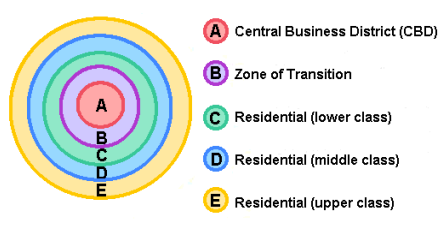
who made the sector model?
hoyt
what is the sector model?
a city develops in a series of sectors as certain areas are more attractive for different activities
as the city grows, activities expand away from the centre
once ‘high-class’ housing is established and the most expensive houses are built on the other end of the district
industrial and retailing activities develop in other sectors as well as low and middle-class residential sectors
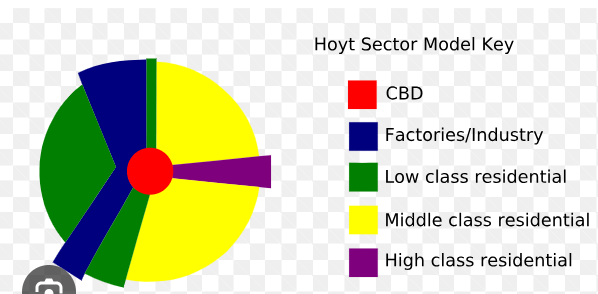
who made the multiple nuclei model?
Harris and Ullman
what is the multiple nuclei model?
a city includes more than one centre that activities revolve around e.g. airports and parks
some activities go together such as universities and bookshops
incompatible land-use activities will not be next to each other e.g. industries next to high class housing
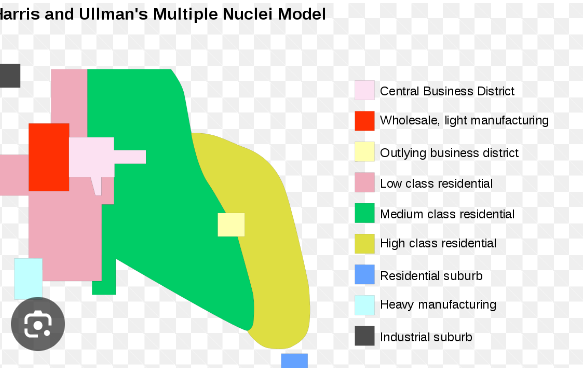
what did Ford’s Latin American city model contain?
a central CBD which the city is built around
the CBD having a commercial spine which is surrounded by elite housing
these areas are surrounded by three concentric zones of housing that decrease in quality as you move away from the core
what were the further revisions of Ford’s model?
the central city should be divided into a CBD and a market area
the spine and elite residential sector now has a mall or edge city to provide goods and services to those in the elite residential sector
malls, edge cities and industrial parks are connected by the ring highway, so it is easier to travel between them
Latin America cities are undergoing gentrification to protect historical landscapes - often in zone of maturity near the CBD
what are the limitations of Burgess’ model?
model does not take into account the physical landscape
Burgess did not consider the development of commuter towns
Urban regeneration, renewal and gentrification has changed inner city housing status
does not consider social/council housing
decentralisation of shops and industry does not fit with the model
what are the limitations to Hoyt’s model?
makes little reference to the physical environment
no reference to out of town developments or commuter settlements
the growth of a sector can be limited as land use is in blocks (contained)
some cities appear to follow this model as it looks at the effects of transport and communication routes
what is bid rent theory?
Bid rent theory shows how the price and demand on land changes as the distance towards the CBD increases
different land users will compete with each other for land close to the city centre
shops wish to maximise their profitability, so they pay more for land closer to the CBD and less for land further away from this area
based upon the idea that the more accessible an area, the more profitable it is going to be
The amount people are willing to pay is called Bid Rent
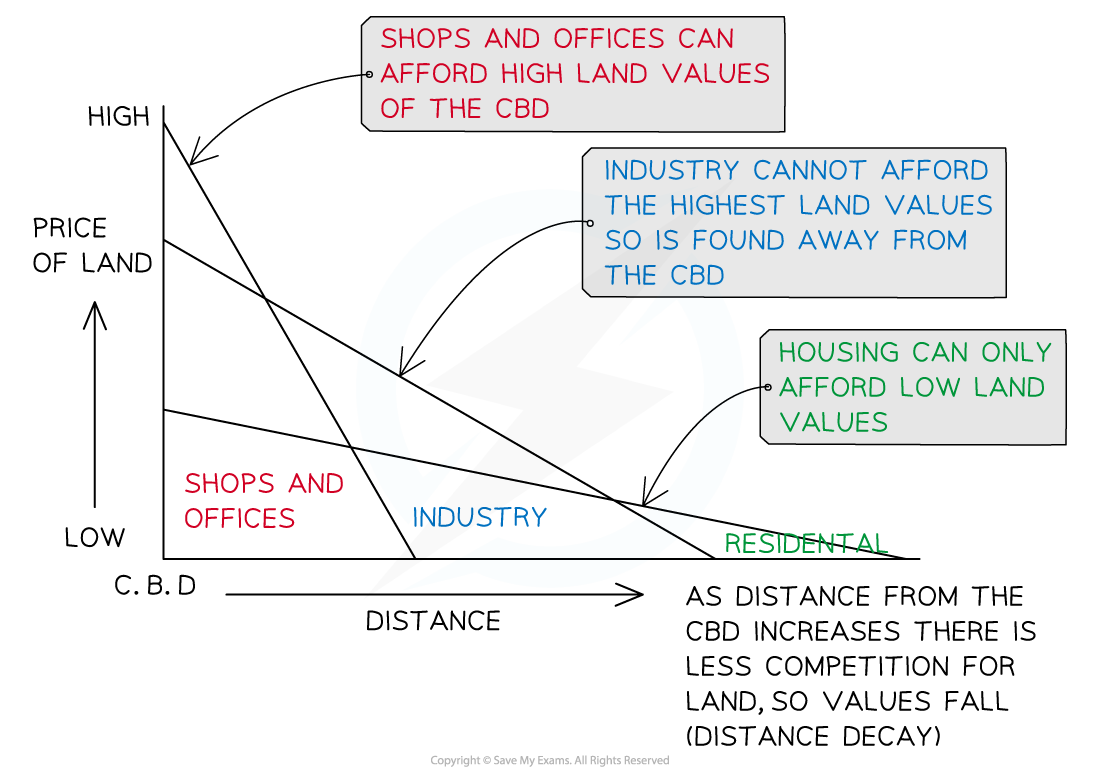
what are the limitations of bid rent theory?
simple, with only 3 broad zones
assumes straight lines for cost curves and no scale
too graphical, compared to map or plan
doesn’t take into account transport networks, planning decisions or physical environment
occasionally low income groups are found in the centre of a city, they were in high density cramped residential buildings as rents were high
what is peak urban land surface value?
a major factor in sorting land uses and people
activities and groups differ in what they can afford
urban land value tends to decline outwards from the core
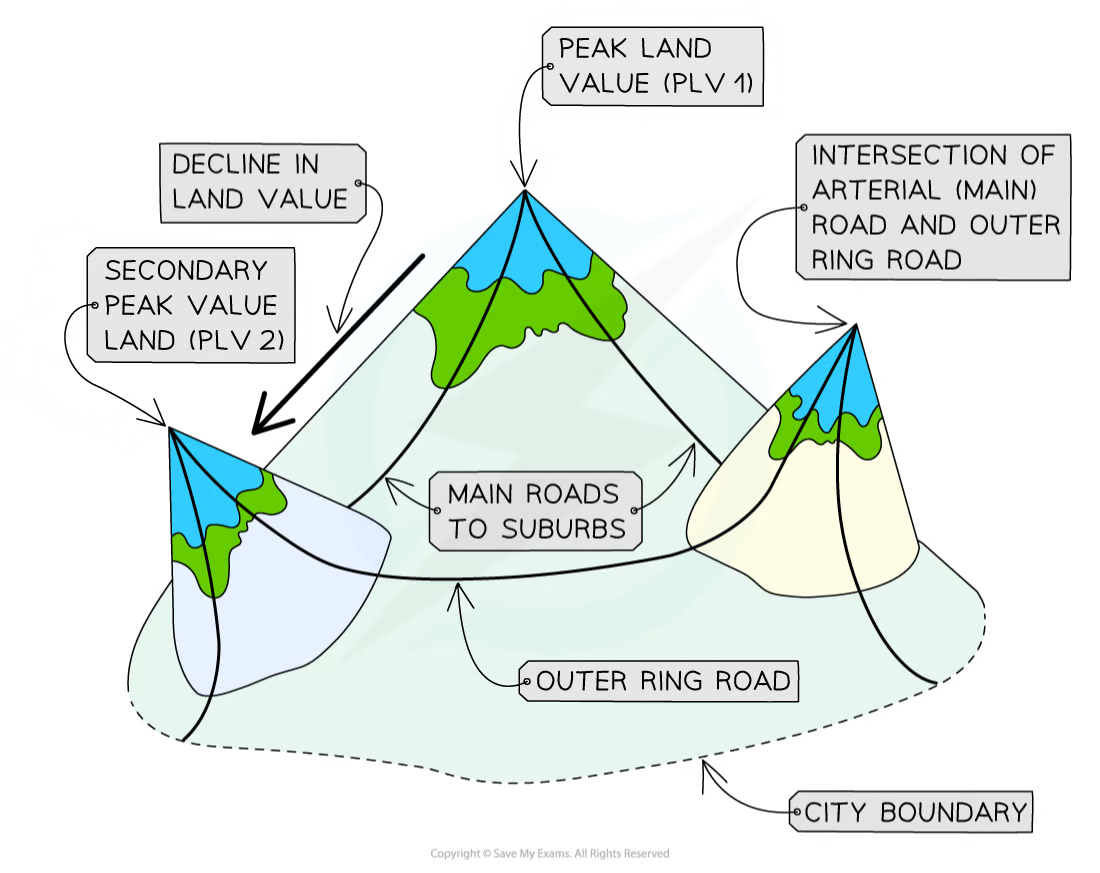
what is urban form?
the main physical elements that structure and shape the city
the physical characteristics of built-up areas including the configuration of settlements
how do new urban landscapes lead to changes in the city centre?
decline in city centres due to the development of out-of-town retail parks and the decentralisation of business and residential areas, which pushed people out of the cbd
push factors of the cbd: high parking costs, congestion, perceptions of the city centre as dirty and unsafe
what are the strategies used to prevent decline?
providing more attractive shopping environments, construction of all-weather shopping malls, improvements in public transport links and the establishment of businesses and marketing team to co-ordinate management of the CBD and run specific events
many cities develop functions other than retail to increase city’s attractions:
a wider range of leisure facilities which offer different services at varying prices and degrees of quality - a range of people will be attracted
the availability of green spaces to provide activities
what is urban morphology?
the study of urban form and of the agents and processes responsible for their transformation over time
how does land influence urban form?
relief - flat land: important for transportation of goods and easier to build on, however is close to rivers and may flood
rivers: can use power of water for energy and transportation
land value: traditionally higher in the centre of cities where accessibility is greatest
retailers: usually only very profitable businesses such as large retailer can afford high prices of higher land value
what are all the new urban landscapes?
town centre mixed developments
cultural and heritage quarters
fortress developments
gentrified areas
edge cities
post-modern western city
what are town centre mixed developments?
city centres have experienced economic decline due to decentralisation meaning urban areas are encouraging activities other than retailing to regenerate an area
what is an example of a town centre mixed development?
Exeter:
Historic quayside redevelopment: vibrant area with a mix of cafes, restaurants, bars, and shops and warehouses have been converted into modern apartments
Prince Shay shopping centre: attracted tourists with boutique shops, cafe’s and restaurants
hoped to develop a night-time economy which would increase safety at night
what are the opportunities and challenges of town centre mixed developments?
opportunities:
job creation
lower crime rates
challenges:
gentrification
increased congestion
what are culture and heritage quaters?
in an attempt to promote growth in cities by focusing on the citys culture and heritage, such as the arts, in order to revitalise the area
what is an example of a culture and heritage quarter?
e.g. jewellery quarter - Birmingham
Museum of the Jewellery Quarter: Offers visitors an immersive experience into the history of jewellery making in Birmingham.
St. Paul’s Gallery: Known for its collection of album cover art and other musical memorabilia.
The Pen Museum: Celebrates the history of pen manufacturing in Birmingham, another key industry historically linked to the area.
The Jewellery Quarter hosts a variety of cultural events throughout the year, including art exhibitions, heritage open days, and jewellery markets.
what are the opportunities and challenges of cultural and heritage quarters?
opportunities:
tourism and economic development
community engagement
challenges:
maintenance costs
lack of diversity
environmental impact
what are fortress developments?
urban developments that have a high focus on security measures
landscapes designed around security, protection and exclusion
e.g. cctv, mosquito alarms, gated areas and fences
what is an example of a fortress development?
Gated communities
High walls and gates: Physical barriers that control entry and exit points.
Security personnel: Private security staff that monitor and patrol the area.
Surveillance systems: Extensive use of CCTV and other surveillance technologies.
exclusive amenities
Private parks and recreational facilities: Tennis courts, golf courses, swimming pools, and gyms.
Private schools and clubs: Education and social venues that are only accessible to residents.
public spaces
Public vs. Private Spaces: There is a stark contrast between the well-maintained private spaces and the neglected public spaces.
Homelessness: The high number of homeless individuals in areas like Skid Row highlights the disparity
urban planning and policy:
Zoning laws: Regulations that allow for the creation of gated communities and restricted-access areas.
Real estate market: High property values and real estate practices that encourage segregation based on income and social status.
what are the opportunities and challenges of fortress developments?
opportunities:
security
controlled access
privacy
amenities
challenges:
social segregation
costly
isolation
aesthetics
what are gentrified areas?
rehabilitation of old houses and streets on an individual basis, but is openly encouraged by estate agents and local authorities
what is an example of a gentrified area?
e.g. Liverpool
run-down housing was sold at low prices - in 2013, Liverpool City Council sold 20 derelict homes for £1 each as long as buyers could show they were capable of renovating the property to a certain standard and agreed to live in the property for 5 years
about 1,000 applicants for each house and the scheme has been extended to other areas to improve the built environment and make it a thriving community
what are the opportunities and challenges of gentrified areas?
opportunities:
purchasing power of residents is higher
leads to a rise in prosperity and an increase in the number of high-status services
challenges:
less affluent residents will have to relocate
what are edge cities?
a concentration of business, shopping, and entertainment outside a traditional downtown or central business district, in what had previously been a suburban residential or rural area.
what is an example of an edge city?
santa monica
Santa Monica is home to numerous corporate headquarters, particularly in the technology, entertainment, and healthcare sectors. Major companies like Hulu, Lionsgate, and Universal Music Group have significant presences in the area.
Santa Monica boasts a vibrant retail environment, highlighted by the Third Street Promenade, a major pedestrian shopping district featuring a mix of national retailers, local boutiques, restaurants, and entertainment venues.
The Santa Monica Place mall, an upscale shopping center, further enhances the city’s retail offerings.
Santa Monica is well-connected by multiple transportation options, including the Expo Line of the Los Angeles Metro, which links the city to Downtown Los Angeles
what are the opportunities and challenges of edge cities?
opportunities:
employment opportunities
increased housing options
increased QOL
mixed-use development
challenges:
strain on infrastructure
congestion
urban sprawl
what is the post-modern western city?
are focused on service and knowledge, with a return of middle-income people from the suburbs into city centres. It accompanies gentrification, upgrades to old or rundown housing and heritage quarters into trendy, flagship homes and developments.
what is an example of a post-modern western city?
Themed Casinos and Hotels: Las Vegas is renowned for its themed resorts that replicate global landmarks and experiences. The Venetian recreates Venice with gondola rides and replica architecture, while Paris Las Vegas features a half-scale Eiffel Tower. These simulations provide visitors with the illusion of traveling the world without leaving the city.
The Strip: The Las Vegas Strip is a showcase of diverse architectural styles, from the Luxor's Egyptian pyramid to the Bellagio's Italianate elegance. This juxtaposition of styles reflects a departure from the modernist emphasis on uniformity and function.
Gambling and Entertainment: Casinos are designed not just for gambling but as immersive environments offering shopping, dining, and entertainment, creating a holistic consumer experience.
Conventions and Events: Las Vegas hosts numerous conventions and events, such as the Consumer Electronics Show (CES) and specialty trade shows. These events transform the city into a hub of commerce and networking, further commodifying the urban experience.
what are the opportunities and challenges of a post-modern western city?
opportunities:
diverse cultural landscape
innovative urban planning
technological advancements
economic opportunities
challenges:
social inequality
environmental sustainability
infrastructure strain
governance and planning
what are some characteristics of town centre mixed developments?
Blends residential, commercial, cultural, institutional or entertainment uses, where those functions are physically and functionally integrated and that provides pedestrian connections
Common in the UK in response to suburbanisation
-> flagship attractions – any major attraction in an urban development with distinct qualities such as uniqueness, location, international reputation and outstanding media attention, making it large in size and economic impact
-> leisure facilities – theatre, cinemas, gyms and restaurants
-> investment in public realm – space around buildings that are publicly accessible, including streets and open spaces. Investment in things like seating areas encourage people back into city areas as places for socialising.
-> accessible public space – places that are generally open and accessible to people
-> residential areas – increases use of other features
-> cultural events – attract people into the city
what is an example of a town centre mixed development?
e.g. Stratford international quarter:
BBC, V&A and Sadlers Wells
UCL campus
Business HQs, TfL and the Financial Conduct Authority
Everyman Cinema
Range of restaurants
Westfield for shopping
Edge of Olympic park for leisure
Multiple high-rise apartment blocks, including new Rondo buildings
what are some characteristics of fortress landscapes?
-> deliberately landscaped and designed around security, protection, surveillance and exclusion
-> planned and physical use of space creates very strong boundaries around urban spaces can lead to the polarisation of society between different groups of people
e.g. gated communities -> not low income, for wealthy residents
CCTV to monitor people in public areas
Mosquito alarms which give out a high pitch sound and stops people congregating in public spaces
Fences and railings – reduces the amount of accessible open spaces for people
Anti-homeless spikes used in doorways
Street lighting used to make people feel safe
'Designing out crime'
what are some characteristics of a post-modern western city?
-> focuses on utility, originality and the struggle between local and cosmopolitan values
Tries to use interesting architecture
-> urban structure – high tech corridors and edge cities – chaotic multi-nodal structure which is chaotic
-> architecture and landscapes – mix of different styles of buildings with different meanings, plus historical references
-> government – services provided by the market rather than public services, plus there are many partnerships between public and private sectors – mobile international capital also encouraged
-> economy – dominated by quaternary and tertiary services, be highly globalised and oriented towards consumption of goods and services
-> planning – stakeholders views incorporated into the decision-making process and the city would be in spatial fragments rather than homogenised sectors
-> culture and ethnicity – reflect a broad range of cultural influences, creating a vibrant, multicultural approach, pluralistic approach